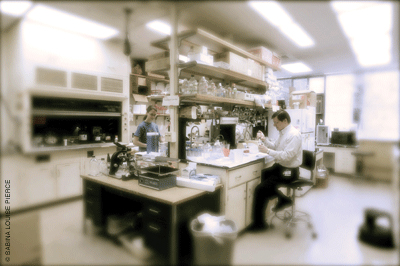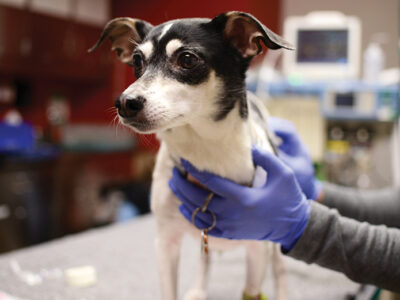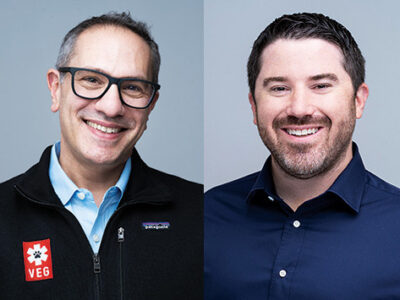
The School of Veterinary Medicine celebrated two significant milestones this past year. One is the 125th anniversary of the school itself, which grew out of Penn’s School of Medicine. The other is the 40th anniversary of its combined VMD/PhD program. In March the school celebrated with a three-day symposium at the recently completed Hill Pavilion that featured talks by such alumni as Ralph Brinster V’60 Gr’64, the Richard King Mellon Professor of Reproductive Physiology who founded the VMD/PhD program, served as its director for 15 years, and continues to make international headlines with his breakthroughs on a regular basis; Michael Kotlikoff C’73 V’81, now dean of Cornell’s College of Veterinary Medicine, who spoke about heart stem cells and heart repair; and Joan Hendricks V’79 Gr’80, the current Gilbert S. Kahn Dean of Veterinary Medicine.
Later that month Gazette senior editor Samuel Hughes sat down with Michael Atchison, the fourth and current director of the VMD/PhD program, to talk about its past, present, and future.
What was the landscape like for veterinary medicine when the VMD/PhD program was founded, both in terms of animal-specific research and its interface with human research?
My understanding is that veterinary specialties were really in their infancy then. But it was clear that veterinarians had a very broad training in multiple species, and research generally uses many different species of animal, so it was recognized that veterinary scientists could play a pretty significant role in pressing forward both human health and animal health. So the idea was to formally train combined-degree veterinary scientists.
From the outset it was clear that the program should be of the highest caliber. Penn has a long history of multi-disciplinary research activities, and Ralph Brinster, very early on, partnered with the graduate groups to deliver the basic science curriculum—you know, the PhD training. He was unwilling to compromise on that scientific training. It had to be the top quality training—no abbreviated PhD thesis, no time-dependent thesis. It’s research-outcome dependent.
So he set the bar very high, that a PhD out of the program would be as good as any PhD out of Penn, and that there be no shortcuts.
We’re the only program like this in the nation, that has the VMD/PhD program associated with the MD/PhD program.
What gaps has the program filled?
That’s an important issue. With the advent of the molecular biology revolution, science became very cellular, molecular, biochemical-based, and physiology began to diminish as a discipline, so there were fewer scientists really trained in whole-animal physiology. MDs do get training in whole-animal physiology, but it’s really one species—human beings. And that is my favorite species. But research really is largely done in a variety of animals, and veterinarians get trained in multiple animal species, so they’re able to determine which animal disease is a good model for a human disease. They’re of course interested in research that benefits animals, because they’re veterinarians, but they’re also very interested in research that benefits human beings. This whole “multiple species, but one medicine” catchphrase that’s popular here at the School of Veterinary Medicine captures that.
Some of the most important stem-cell research in the country has been done in the Vet school, or by people with ties to it. What are some other important areas of research?
Cancer biology is one area where veterinary scientists are making significant inroads. The big problem in cancer research is, we’ve gotten really good at curing mice of cancer, but when you apply that to normal, spontaneous cancers in human beings, the translation often is nil. So we’ve learned well that human beings are not large rodents.
We have spontaneous disease walking in the door every day—tumors, you know, various cancers—into the veterinary clinics, and there’s significant progress being made in trying to use these spontaneous diseases as a way to learn how to treat various forms of cancer, that can then be applied to human beings.
Transgenic biology really started here at this school, through Ralph Brinster and Richard Pommeter making the first transgenic animals. There’s a lot of strong reproductive biology that’s come out of here. Neuroscience has been fairly strong in the vet school.
Another area that veterinarians are really beginning to excel in is infectious-disease research. Like, 60 percent of new emerging diseases are zoonotic—they come from animals, and hop into humans. How diseases spread between species—it’s really veterinarians that know that well. So they’re on the forefront of public health, disease outbreaks.
How important is this program?
Now, Penn gets criticized a lot for being arrogant, but this is a particular case where we don’t have strong competitors, and that’s actually not a good thing. There’s a need for more veterinary scientists.
Penn has this incredibly unique environment for a vet school. Most vet schools are not on a campus like this. They’re land-grant institutions, you know, in an agricultural area. They don’t have a strong research focus in many cases. But the vet school here actually grew out of the med school. All the first faculty were MDs, and it was the medical school recognizing that they needed people trained in animals.
Penn is a top-tier research university. The vet school has that same top-tier research mentality. So scholarship, basic scientific research, is something that we value very highly. And this combined-degree program is something we think we do extraordinarily well. We’re extraordinarily proud of our graduates. Basically, they are our Exhibit A.
What areas do most of your graduates go into?
Nearly all of our graduates have been in the biomedical graduate studies, and those are the standard scientific disciplines—biochemistry, neurobiology, you know, cell and molecular, those sort of standard disciplines. But they’re not exclusively limited to that.
Any particularly offbeat areas?
We have a student now who is likely to be switching into city planning. She wants to design facilities that minimize infectious-disease spread. Many parts of the world have these open-air markets, you know, and that’s where diseases come out of. So she’s interested in infectious disease, but partly from a city-planning and architectural angle, to contain diseases.
Are there any other issues that you see, just in general?
Well, we’re thinking the infectious-disease direction will continue for the foreseeable future. We believe the cancer-biology direction will be a rich area for veterinary scientists. Neuroscience has some advantages as well. Penn has got a very strong neurosciences group, and there’s traditionally been a lot of good neuroscientists here at the vet school.
We’re also strong in genetics. With so many animal genomes now being sequenced, veterinary geneticists are beginning to really exploit those genomes for understanding the identity of a variety of diseased genes. So the dog genome, the cat genome, are done. And some breeds of animals are predisposed to certain diseases, so by using genetic approaches, they can address what are the genes that are defective in these different strains of animals that cause these genetic diseases.




